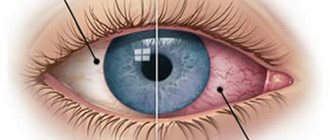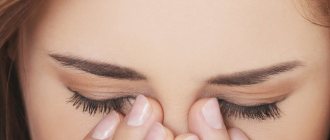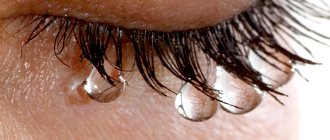Tears protect the eyes from external irritants. This condition does not pose anything dangerous, but it brings discomfort to a person’s life. Eyes may become watery in the sun for the following reasons:
- the wind is blowing outside;
- the sun does not warm, events take place in winter at low air temperatures;
- the person yawns or sneezes frequently.
These reasons lead to a narrowing of the lacrimal canal, which provokes an abundant release of its contents. The phenomenon does not require intervention from medical professionals.
Often, tearfulness increases when going out into the sun, when there is no direct view of the heavenly body, but there is discomfort. Usually in such cases, doctors consider it an allergy, which is also characterized by other symptoms:
- Puffiness of the eyelids - the eyes swell, the upper eyelids droop. In this case, instead of the usual size of the eyes, only a narrow gap remains.
- Redness of the eyeball and lower/upper eyelid. It can be local, for example, affecting only the edges of the eyelids or exclusively the eyeball. But most often, hyperemia due to sun allergies is diffuse; pronounced red circles with a dark tint form around the eyes.
- Pain, feeling of pressure from inside. This symptom appears only in the absence of treatment and too long exposure to sunlight. First, the eyes begin to hurt when you touch them, then the same sensations are present “at rest.” Due to pressure from within, patients complain of a sudden headache that is not relieved by conventional painkillers.
- The itching is obsessive and cannot be relieved even with ointments. The eyes begin to itch from the eyelids, then a sensation occurs directly in the mucous membrane of the eyeball.
Reasons why a child may cry when going outside in sunny weather:
- a wave of wind hits your face - the tear ducts are forced to produce liquid, which is designed to protect the eyes from dust and dirt;
- there was a too sudden exit from the shadows into bright light - lacrimation in this case is also a defensive reaction, since the child is squinting.
But if the eyes are not only watery, but also red and itchy (the baby constantly rubs them with his fists), then you should think about an allergy to the sun . Only a doctor can accurately determine the condition and understand the cause of excessive lacrimation in childhood.
Often the problem arises against the background of underdevelopment of the lacrimal canals (they may be atrophied or subject to dystrophic processes, incorrectly located or have deviations in their anatomical structure).
The cause of eye swelling in a child may be atrophy of the lacrimal ducts
Other causes of watery eyes in the sun:
- conjunctivitis is an inflammatory disease, often seasonal, and may be accompanied by eyelashes sticking together during sleep;
- foreign body - even the smallest speck in the eye causes profuse lacrimation, while scratching, slight tingling and burning are felt in the eyeball;
- excessive fatigue - for example, if a person has been working at a computer for a long time or on small parts in poor lighting, then when going out into bright light there will be symptoms characteristic of an allergic reaction.
An ophthalmologist can also identify conditionally pathological conditions that lead to lacrimation - incorrectly selected contact lenses or corrective glasses, deficiency of vitamin B12, potassium in the body, prolonged stay in a room with too hot and dry air.
If it is known for sure that the cause of lacrimation is an allergy to the sun, then you will need to take a course of antihistamines : Zyrtec, Claritin, Zodak - modern and effective, do not have a negative effect on the nervous system and brain function.
As an additional measure, you can use “Artificial tear” eye drops, which moisturize the mucous membrane of the eyeball and help expand the tear ducts. They need to be used 3-5 times a day, placing 1-2 drops in each eye.
How to put eye drops correctly
Ophthalmologists also recommend:
- eat more apricots - the pulp of the fruit contains lutein, which can soften the effect of sunlight on the retina;
- introduce carrot juice to the menu - this will strengthen the immune system and saturate the tissues of the visual organs with vitamin A;
- apply lotions made from decoctions of chamomile, linden flowers, mint leaves or black tea to the eyes several times a day.
Read more in our article about why your eyes water in the sun.
Natural reasons why eyes water in the sun
Tears protect the eyes from external irritants, so even with a slight impact on the tear ducts, fluid may appear from them. This condition does not pose anything dangerous, but it brings discomfort into a person’s life, especially for women who use decorative cosmetics.
Eyes may become watery in the sun for the following reasons:
- there is wind outside;
- the sun does not warm, events take place in winter at low air temperatures;
- the person yawns or sneezes frequently.
These reasons lead to a narrowing of the lacrimal canal, which provokes an abundant release of its contents. But this phenomenon is natural, physiological and does not require intervention from medical professionals.
We recommend reading the article about sunburn of the eyes. From it you will learn about the causes of sunburn of the eyes, symptoms of retinal damage and treatment of sunburn of the eyes. And here is more information about what to do if you feel chilly after the sun
Allergy and its symptoms: eyes are swollen, painful
Often, tearfulness increases when going out into the sun, when there is no direct view of the heavenly body, and discomfort is present in full. Usually in such cases, doctors consider allergies as the cause of this condition. It is also characterized by other symptoms:
- Puffiness of the eyelids - the eyes become swollen, the upper eyelids hang over the eyeballs. This condition may manifest itself too intensely and in this case, instead of the usual size of the eyes, only a narrow gap remains.
- Redness of the eyeball and lower/upper eyelid. It can be local - for example, affecting only the edges of the eyelids or exclusively the eyeball. But most often, hyperemia due to sun allergies is diffuse and pronounced red circles with a dark tint form around the eyes.
- Pain, feeling of pressure from inside. This symptom appears only in the absence of treatment and too much exposure to sunlight. First, the eyes begin to hurt when you touch them, then the same sensations are present “at rest.” Due to pressure from within, patients complain of a sudden headache that is not relieved by conventional painkillers.
- The itching is obsessive and cannot be relieved even with local medications (ointments). The eyes begin to itch from the eyelids, then the person experiences a sensation of itching directly in the mucous membrane of the eyeball.
All symptoms of sun allergy are interconnected - excessive lacrimation provokes irritation and itching, scratching the eyes aggravates the primary problem, the skin of the eyelids begins to swell and redden.
Why do children get watery from the sun and wind?
Parents should know that the child begins to produce tears only at the age of three months, and before that he will cry without tears and there will be no spontaneous lacrimation. If a child has a problem when going outside in sunny weather, this can be explained by two factors:
- a wave of wind hits your face - the tear ducts are forced to produce liquid, which is designed to protect the eyes from dust and dirt;
- there was a too sudden exit from the shadows into bright light - lacrimation in this case is also a defensive reaction, since the child is squinting.
But if a child’s eyes are not only watery, but also red and itchy (the baby constantly rubs them with his fists), then you should think about an allergy to the sun. Only a doctor can accurately determine the condition and understand the cause of excessive lacrimation in childhood.
Often the problem arises against the background of underdevelopment of the lacrimal canals - they can be atrophied or subject to dystrophic processes, be incorrectly located or have deviations in their anatomical structure.
Other causes of watery eyes in the sun
In addition to an allergic reaction, some pathological conditions can also be the reasons for the appearance of too many tears when going out into the sun:
- conjunctivitis is an inflammatory disease, often seasonal, and may be accompanied by eyelashes sticking together during sleep;
- foreign body - even the smallest speck in the eye causes profuse lacrimation, while scratching, slight tingling and burning are felt in the eyeball;
- excessive fatigue - for example, if a person has been working at a computer for a long time or on small parts in poor lighting, then when going out into bright light there will be symptoms characteristic of an allergic reaction.
These conditions require seeking qualified medical help, and you may need to prescribe a course of drug therapy. An ophthalmologist can also identify conditionally pathological conditions that lead to lacrimation - incorrectly selected contact lenses or corrective glasses, deficiency of vitamin B12, potassium in the body, prolonged stay in a room with too hot and dry air.
Red eye syndrome
If the right eye of an adult is watery, the phenomenon may be the result of the development of red eye syndrome. One of the main consequences of an ophthalmological disorder is a malfunction of the glands that are responsible for tear production. The eyeball regularly suffers from dryness. The result is redness of the whites of the eyes, irritation of local tissues and profuse lacrimation.
A person who suffers from the development of the syndrome periodically feels a burning sensation in the visual organ. The unpleasant effect when the right eye constantly waters becomes a natural reaction to exposure to a negative factor.
Red eye syndrome can develop under the influence of the following phenomena:
- malfunctions of the cornea as a result of long-term use of hormonal medications;
- formation of chronic conjunctivitis;
- progress of vegetative-vascular diseases;
- disturbance of sleep and wakefulness;
- daily exposure to rooms with dry air;
- regular contact with aggressive chemicals in hazardous industries;
- prolonged work in front of a computer monitor.
What to do to get rid of watery eyes
If it is known for sure that the cause of lacrimation is an allergy to the sun, then you will need to take a course of antihistamines. Effective ones include Ceterizine, Tavegil, Diazolin, Suprastin - 2-3 generation drugs that can cause side effects such as increased drowsiness and loss of concentration.
Doctors recommend using the latest generation of drugs to block histamines - Zyrtec, Claritin, Zodak: they do not have a negative effect on the nervous system and brain function.
As an additional measure, you can use “Artificial tear” eye drops, which moisturize the mucous membrane of the eyeball and help expand the tear ducts. They need to be used 3-5 times a day, placing 1-2 drops in each eye.
Ophthalmologists also recommend:
- eat more apricots - the pulp of the fruit contains lutein, which can soften the effect of sunlight on the retina;
- introduce carrot juice to the menu - this will strengthen the immune system and saturate the tissues of the visual organs with vitamin A;
- apply lotions made from decoctions of chamomile, linden flowers, mint leaves or black tea to the eyes several times a day.
We recommend reading the article about what to do if your nose is burned. From it you will learn what to do if your nose is burned, what not to do if you get a burn, when you need to see a doctor and preventive measures in the sun. And here is more information about how long it takes for redness to go away after sunbathing.
If your eyes water in the sun, you must first find out the true cause of this condition. If an allergy to ultraviolet rays is confirmed, it is enough to take a course of antihistamines - they will alleviate the condition after the first dose, but the best result will be after 2-3 days of using the drug. And then you need to exclude the irritating factor from the life of an allergy sufferer - wear special sunglasses, spend most of the time in the shade.
Effective treatments
Effective treatment is only possible if the diagnosis is correct. Tearfulness can be caused by various reasons. Therefore, therapy in each specific case may differ.
Very often this symptom is caused by an allergy. In case of allergic tearing of the eyes, a specialist may recommend taking systemic antihistamines:
- Zodak;
- Telfast;
- Fenistil;
- Erius.
But the main emphasis in treatment is on drops. Depending on the diagnosis, different groups of these drugs can be used for tearing.
Antihistamine eye drops
You can block excessive histamine production with special antihistamine drops. They eliminate tearing and other manifestations of allergies in the eyes.
Effective antihistamine drops:
- Opatanol;
- Cromohexal;
- Allergodil;
- Ketotifen.
Note! When choosing antihistamine eye drops for children, it is necessary to take into account age indications. Most of them can only be used after 2-4 years.
If tearing is accompanied by an inflammatory process, use anti-inflammatory drops (non-steroidal or hormonal):
- Acular;
- Diklo-F;
- Dexamethasone;
- Prenatsid.
Combined drops help well, which in addition to the antiallergic effect have a vasoconstrictor and anti-inflammatory effect:
- Tobrex;
- Sofradex.
If the reaction of the eyes is associated with their overstrain (at the computer, while driving), drops are used that wash the mucous membrane and protect it from drying out:
- Nafkon-A;
- Naphazoline;
- Visine;
- Okumetil.
The above drops cannot be used for a long time, as this will lead to the opposite reaction - dry eyes. Therefore, it is better to resort to their help in rare cases.
If tearing is associated with damage to the cornea (for example, due to exposure to UV radiation, a welding machine), it is recommended to rinse the eyes with antiseptic solutions (Ocomistin, Vitabact) or antibiotic ointment (Levomycetin).
Learn about the symptoms of contact dermatitis in infants and the treatment of the pathology.
See the list and characteristics of inexpensive tablets for skin allergies on this page.
Go to the address and read about the symptoms and treatment of allergic laryngitis.
Useful video
Watch the video about eye diseases from the sun:
Similar articles
- Sunburns of the eyes: causes, symptoms, treatment...
Sunburns of the eyes occur not only due to direct gaze at the luminary. For example, you can get them in the mountains, when looking at the snow. Symptoms are sharp pain in the eyes, inability to see daylight. Treatment of a retinal burn is carried out by a doctor; you can only relieve the symptoms on your own. Read more - Chills after the sun: why and what to do after sunbathing
If you feel chilly after the sun, then this is a sure sign of a burn. If there are no more severe symptoms - vomiting, high fever, then you can make compresses from traditional medicine or use medications. If you have them after sunbathing, you should consult a doctor. Read more
- Burnt nose: first aid, what to do if...
Quite often, both at sea and just when walking along the streets, it happens that your nose gets burned. In this case, first aid is the use of ointments for sunburn. You can also make compresses, and if your nose is peeling, then gentle peelings. Read more
- How long does redness last after sunbathing?
How long redness lasts after sunbathing is influenced by two factors - individual reaction and the degree of burn. For example, with mild redness it will be possible to get rid of it in 2 days, with severe hyperemia it will take up to 10 days. What can I do to speed up healing time? Read more
- Solcoseryl for burns: is it possible to smear, what is better...
Is it possible to use Solcoseryl for burns? Which form is better to choose - ointment, gel. Rules for using Solcoseryl for sunburn on the face and body. Read more
Photophobia as a symptom of diseases
If photophobia is observed for a long time, it can be a symptom of various diseases. This symptom is accompanied by many ophthalmological diseases.
Migraine
Migraine is a chronic neurological disease. A distinctive feature of this disease is pain on one side of the head. The cause of attacks may be a violation of cerebral circulation, central nervous system disease, low or high blood pressure.
In people prone to migraines, an attack can be triggered by a change in weather, a stressful situation, being in a stuffy room, or overwork. Pain in the temple or eyebrow area can be triggered by noise, bright light and certain odors.
A contrast shower, a good night's sleep or a cup of warm tea will help to quickly stop an attack. Such people should try to rest more and lead a healthy lifestyle.
Glaucoma
Glaucoma is caused by increased intraocular pressure. This disease is accompanied by impaired visual fields and deterioration of visual function. A feature of glaucoma is a change in the color of the pupil, it becomes greenish or blue.
The disease can be triggered by a violation of the outflow of intraocular fluid. The cause of the disease can be infections and stressful situations. long-term use of hormones and ophthalmological diseases. All patients are at risk. over 50 years of age.
Treatment is always complex. Eye medications are prescribed that normalize the outflow of fluid from the eyes and stabilize intraocular pressure. In parallel, you should take medications aimed at eliminating the root cause of the pathology.
Dacryocystitis
Dacryocystitis is characterized by obstruction of the nasolacrimal ducts and inflammation of the lacrimal sac. This disease is more often observed in newborns in whom the membrane blocking the ducts has not ruptured soon after birth. But in certain cases, the disease can also affect adults. This phenomenon can be caused by diseases of the nasopharynx, which are accompanied by severe inflammation, as well as a number of infectious ophthalmological diseases.
Dacryocystitis is accompanied by photophobia, suppuration and swelling of the eye. In the morning, it is difficult for the patient to open his eyelids, since the eyelashes are literally glued together with purulent masses.
Treatment can be conservative or surgical. Conservative involves massage of the tear ducts and subsequent use of antibacterial drops. If therapy is ineffective for a month, then surgical intervention is resorted to.
Probing of the nasolacrimal ducts in children is done under local anesthesia only until they reach 3 months; local anesthesia is indicated for older children.
Conjunctivitis
With conjunctivitis, pain and pain in the eyes are also observed. It is difficult for the patient to look at bright light, his eyes constantly water. The disease can be viral, bacterial, fungal and allergic.
A distinctive sign of conjunctivitis is suppuration from the eyes; this symptom is more pronounced in the bacterial form of the disease. The eyelashes stick together strongly in the morning, and it is difficult for the patient to open the eyelids after sleep. Eyes are swollen, red and itchy.
Bacterial and viral conjunctivitis are highly contagious. You can become infected from a sick person through a towel, glasses, cosmetics and various household items.
Infectious diseases of the head
Various infectious diseases of the membranes of the brain can also provoke pain in the eyes. This includes meningitis and encephalitis. These diseases are accompanied by severe headaches, dizziness and loss of coordination. Symptoms of intoxication and headache are observed.
Treatment boils down to prescribing antibiotics. Broad-spectrum medications are prescribed. These may be medications from a number of penicillins or cephalosporins. Most often, antibiotics from different groups are combined to increase efficiency.
Myopia
People with myopia also often experience eye pain from bright light. This is due to the fact that a person’s visual function is impaired and he has to constantly strain his visual organs. Bright light in this case is an additional source of irritation.
Other pathologies
Eye pain can also occur due to allergies. Household dust, medications, food products, fluff and feathers can trigger an allergic reaction. Many people develop allergies to pollen at certain times of the year.
The allergy is accompanied by nasal congestion, frequent sneezing and watery eyes. Many people experience allergic rashes, photophobia and lacrimation.
To eliminate allergy symptoms, it is enough to take antihistamines. This includes Tavegil, Tsetrin. Loratadine, Suprastin and Diazolin.
Pain in the visual organs also occurs due to accidental eye injuries. The ingress of small debris, midges and branches leads to irritation of the mucous membrane and pain. Treatment is prescribed by a doctor; in some cases, antibacterial drops and artificial tear preparations are prescribed.











